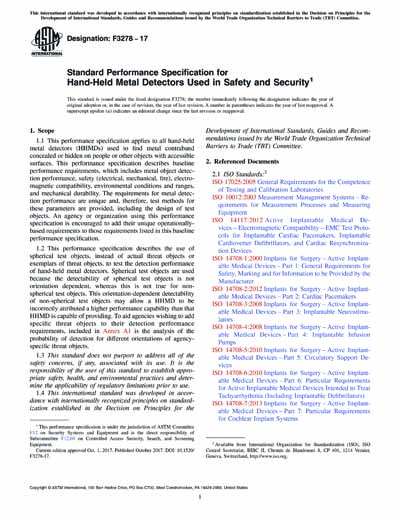Historical
ASTM F3278-17
Standard Performance Specification for Hand-Held Metal Detectors Used in Safety and Security
1.1 This performance specification applies to all hand-held metal detectors (HHMDs) used to find metal contraband concealed or hidden on people or other objects with accessible surfaces. This performance specification describes baseline performance requirements, which includes metal object detection performance, safety (electrical, mechanical, fire), electromagnetic compatibility, environmental conditions and ranges, and mechanical durability. The requirements for metal detection performance are unique and, therefore, test methods for these parameters are provided, including the design of test objects. An agency or organization using this performance specification is encouraged to add their unique operationally-based requirements to those requirements listed in this baseline performance specification.
1.2 This performance specification describes the use of spherical test objects, instead of actual threat objects or exemplars of threat objects, to test the detection performance of hand-held metal detectors. Spherical test objects are used because the detectability of spherical test objects is not orientation dependent, whereas this is not true for non-spherical test objects. This orientation-dependent detectability of non-spherical test objects may allow a HHMD to be incorrectly attributed a higher performance capability than that HHMD is capable of providing. To aid agencies wishing to add specific threat objects to their detection performance requirements, included in Annex A1 is the analysis of the probability of detection for different orientations of agency-specific threat objects.
1.3 This standard does not purport to address all of the safety concerns, if any, associated with its use. It is the responsibility of the user of this standard to establish appropriate safety, health, and environmental practices and determine the applicability of regulatory limitations prior to use.
1.4 This international standard was developed in accordance with internationally recognized principles on standardization established in the Decision on Principles for the Development of International Standards, Guides and Recommendations issued by the World Trade Organization Technical Barriers to Trade (TBT) Committee.
Content Provider
ASTM International [astm]






